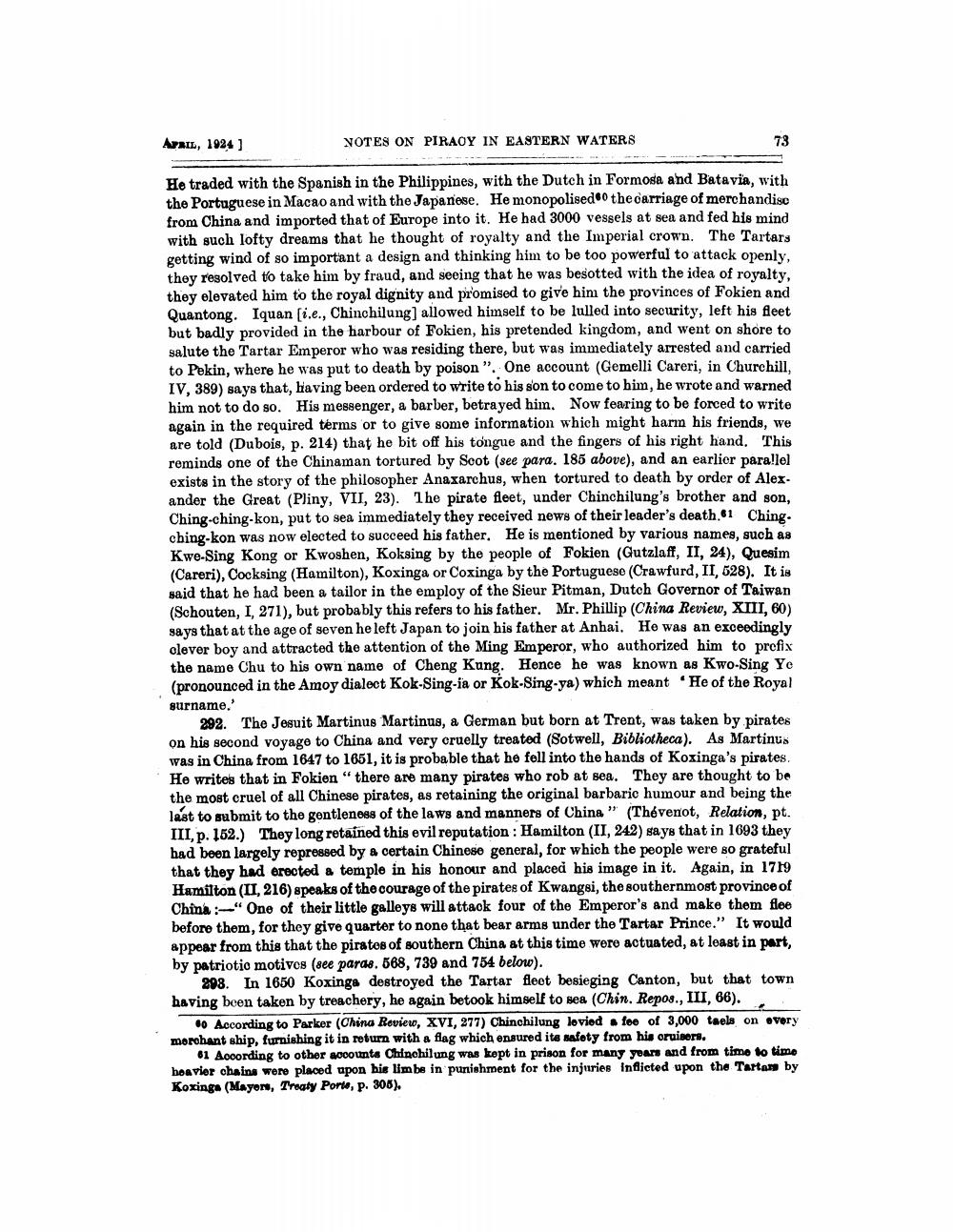________________
APRIL, 1924 ]
NOTES ON PIRAOY IN EASTERN WATERS
He traded with the Spanish in the Philippines, with the Dutch in Formosa and Batavia, with the Portuguese in Macao and with the Japanese. He monopolised the carriage of merchandise from China and imported that of Europe into it. He had 3000 vessels at sea and fed his mind with such lofty dreams that he thought of royalty and the Imperial crown. The Tartars getting wind of so important a design and thinking him to be too powerful to attack openly, they resolved to take him by fraud, and seeing that he was besotted with the idea of royalty, they elevated him to the royal dignity and promised to give him the provinces of Fokien and Quantong. Iquan [i.e., Chinchilung] allowed himself to be lulled into security, left his fleet but badly provided in the harbour of Fokien, his pretended kingdom, and went on shore to salute the Tartar Emperor who was residing there, but was immediately arrested and carried to Pekin, where he was put to death by poison". One account (Gemelli Careri, in Churchill, IV, 389) says that, having been ordered to write to his son to come to him, he wrote and warned him not to do so. His messenger, a barber, betrayed him. Now fearing to be forced to write again in the required terms or to give some information which might harm his friends, we are told (Dubois, p. 214) that he bit off his tongue and the fingers of his right hand. This reminds one of the Chinaman tortured by Seot (see para. 185 above), and an earlier parallel exists in the story of the philosopher Anaxarchus, when tortured to death by order of Alexander the Great (Pliny, VII, 23). The pirate fleet, under Chinchilung's brother and son. Ching-ching-kon, put to sea immediately they received news of their leader's death.61 Ching. cbing-kon was now elected to succeed his father. He is mentioned by various names, such as Kwe-Sing Kong or Kwoshen, Koksing by the people of Fokien (Gutzlaff, II, 24), Quesim (Careri), Cocksing (Hamilton), Koxinga or Coxinga by the Portuguese (Crawfurd, II, 528). It is said that he had been a tailor in the employ of the Sieur Pitman, Dutch Governor of Taiwan (Schouten, I, 271), but probably this refers to his father. Mr. Phillip (China Review, XIII, 60) says that at the age of seven he left Japan to join his father at Anhai. He was an exceedingly clever boy and attracted the attention of the Ming Emperor, who authorized him to prefix the name Chu to his own name of Cheng Kung. Hence he was known as Kwo-Sing Yo (pronounced in the Amoy dialect Kok-Sing-ia or Kok-Sing-ya) which meant He of the Royal surname.
292. The Jesuit Martinus Martinus, a German but born at Trent, was taken by pirates on his second voyage to China and very cruelly treated (Sotwell, Bibliotheca). As Martinus was in China from 1647 to 1651, it is probable that he fell into the hands of Kozinga's pirates. He writes that in Fokien "there are many pirates who rob at sea. They are thought to be the most cruel of all Chinese pirates, as retaining the original barbaric humour and being the last to submit to the gentleness of the laws and manners of China" (Thévenot, Relation, pt. III, p. 152.) They long retained this evil reputation : Hamilton (II, 242) says that in 1693 they had been largely repressed by a certain Chinese general, for which the people were so grateful that they had erected a temple in his honour and placed his image in it. Again, in 1719 Hamilton (LI, 216) speaks of the courage of the pirates of Kwangsi, the southernmost province of China :-"One of their little galleys will attack four of the Emperor's and make them flee before them, for they give quarter to none that bear arms under the Tartar Prince." It would appear from this that the piratos of southern China at this time were actuated, at least in part, by patriotio motivos (see paras. 568, 739 and 754 below).
298. In 1650 Koxinga destroyed the Tartar fleet besieging Canton, but that town having been taken by treachery, he again betook himself to sea (Chin. Repos., III, 66).
40 According to Parker (China Review, XVI, 277) Chinchilung loviod foe of 3,000 taels on every morohant ship, furnishing it in return with a flag which ensured its safety from his oruisers.
61 According to other accounts Chinchilung was kept in prison for many years and from time to time hoavior chains were placed upon his limbe in punishment for the injuries inflicted upon the Tartan by Koxinga (Mayon, Treaty Porto, p. 308).




